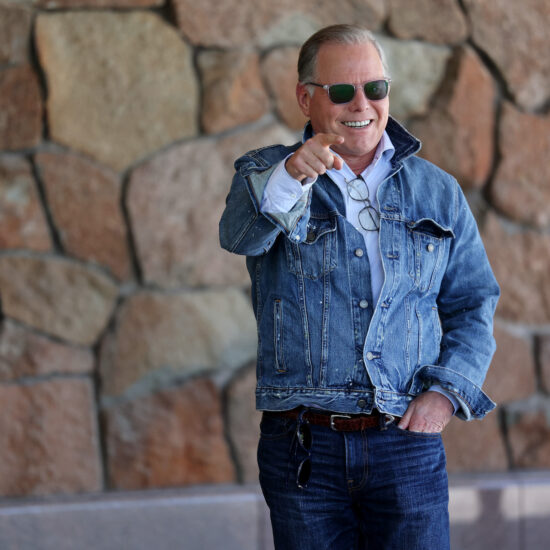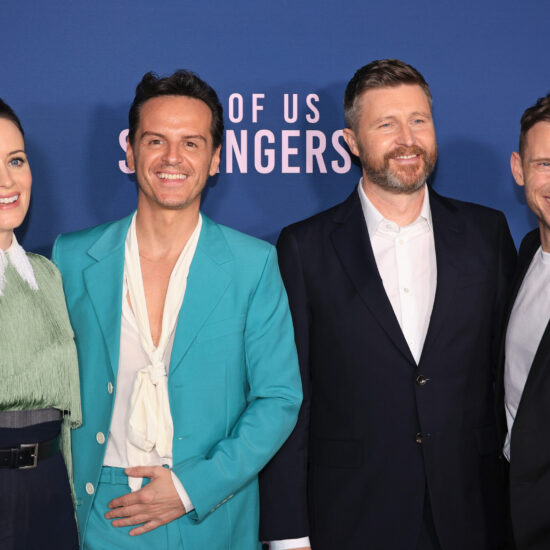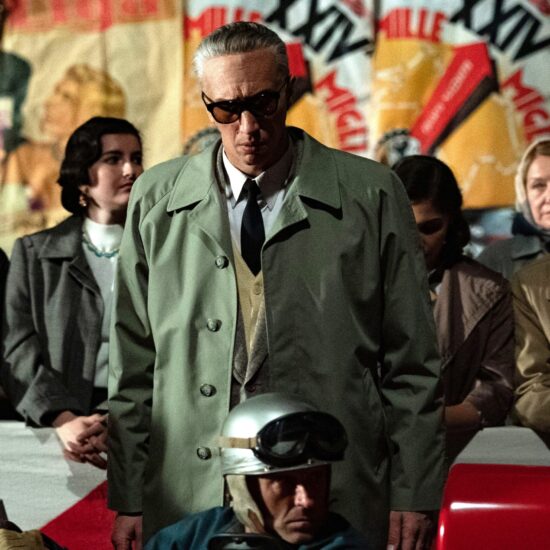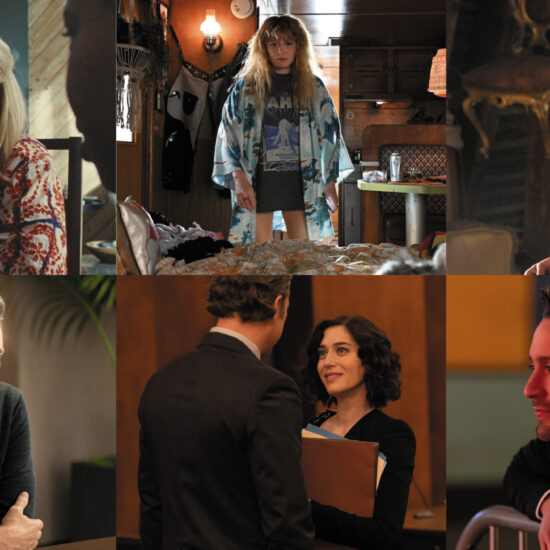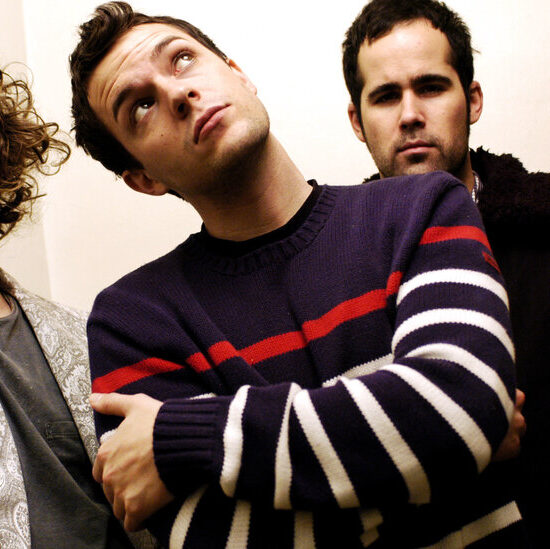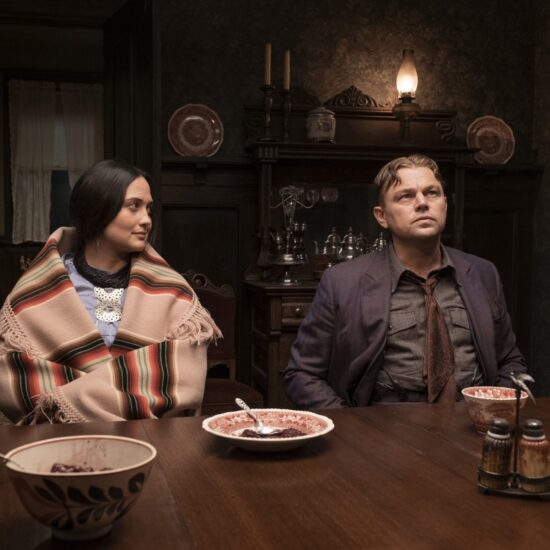
When Eric Roth first adapted non-fiction master David Grann’s extraordinary 2017 work, “Killers of the Flower Moon: The Osage Murders and the Birth of the FBI,” Leonardo DiCaprio, who first optioned the book, and director Martin Scorsese weren’t feeling it.
The story was fascinating and terrible: A group of white men, led by William “King” Hale, exploited and effectively exterminated at least 20 (and likely many more) members of the oil-rich Osage Nation in Oklahoma back in the 1920s. DiCaprio, in his sixth collaboration with Scorsese, was set to play the book’s riveting hero, FBI investigator Tom White, who solved many of the murders and put Hale in prison. Only problem was, after an early table read right before the pandemic, DiCaprio didn’t want to play White. He proposed that he should play Hale’s nephew, Ernest Burkhart, who executed many of the murders at his uncle’s behest.
A very different movie emerged, one that focused on how Hale (Robert DeNiro, his 10th movie with Scorsese) directed his nephew to romance and marry Mollie, a rich Osage woman (Lily Gladstone). As is his wont, Scorsese went on to create a gorgeous $200-million, three-and-a-half-hour epic, financed by AppleTV+ and shot by Rodrigo Prieto with production design by Jack Fisk, that focused more on the Osage and less on their white FBI savior (Jesse Plemons as White), who now doesn’t turn up until the two-hour mark.
The movie debuted at Cannes to rave reviews, and opened October 20 in theaters via Paramount Pictures. After 45 days it will stream on Apple TV+. As the award season gets under way, “Killers of the Flower Moon” is poised to exceed “The Irishman”‘s 10 Oscar nominations. And might even win some.
I spoke to Scorsese, as engaging a subject as any interviewer could desire, in L.A.
The following interview has been edited and condensed for clarity. Please note: spoilers abound.
Anne Thompson: If you had made this movie before the pandemic, what movie would it have been?
Martin Scorsese: We would have found ourselves at that juncture where we realized that the path we were taking was something that we weren’t going to do. And I don’t think the picture would have been made, between myself and Leo.
The creative process of finding the heart of it, and figuring out where it had to go, would have happened anyway?
Yeah, because [Leo is] the main thing for me, meaning, which character is he going to play? Would I have enjoyed the Texas Rangers in the past? Yes, I would have, but not at my age now. If it was me, 20 or 25 years ago, I’d say, “Yeah, let’s do a foray into the American West, from the European American’s point of view.” That doesn’t mean it has to be hagiographic for them in any way, or revisionist; it’s an honest look at it. But over the years, that’s changed. And so it changed a great deal from the early ’70s, when I was 29, 30 years old, and began to realize that the Western the way I imagined it from the beautiful, extraordinary films made by the Hollywood studios in the ’40s and ’50s had been designed with a certain philosophy and political point of view.
Do you think this is a Western? It’s a gangster movie!

No, not really. That’s what I’m saying. It’s kind of a gangster movie. Yeah, there is not much difference between what [Bill Hale and his cronies] do and what the crime families did in Chicago, and then New York at the turn of the century 1900 to 1950, where I grew up around them. It’s just that it may have been not as wide-ranging. With organized crime, you have an overall structure of evil. Here, it’s specific, in certain areas, locations. It reflects a point of view, and a sense of, “We are superior to you. You don’t know what’s good for you, you don’t know how to handle money. We do. And by the way, in the meantime, if you don’t know how to handle money, well, we can help you with that. As long as we get a good, good chunk of it ourselves.”
One slip adds to another, and then ultimately: “If this particular person, she’s so old, she’s going to die anyway. He’s drinking too much. Or he has a problem over here and he’s just going to crash his car one day, the way he drives. OK, so maybe we should just push them over the edge and they’re gonna go anyway, and so we’ll make some money on it.”
As you worked with Eric Roth and DiCaprio on the script, his character Ernest Burkhart is a tad dim and does what his uncle tells him to do. Ernest loves his Osage wife Mollie at the same time that he’s killing her. This becomes the heart of the movie?
We realized that was really the heart of the film. And having met with the Osage so many times and heard from Margie Burkhart, who was the great-great-granddaughter of Ernest, she knew them. She kept saying, “Don’t forget it isn’t as simple as villains and victims. You have to remember Mollie and Ernest were in love.” And that always stayed with me when we were still working on the other version of the script. I said, “Well, if they’re in love, we got to show that too.” And then that became difficult in terms of showing all the machinations of the Bureau investigation. Plus, this love story, it was getting unwieldy. And then finally Leo said, “If I play Ernest, we could turn it upside down and go in from the ground level.” And I said, “Absolutely.”
So DiCaprio was the first driver of that change.
Absolutely. Because we were trying to find something for him to play with [FBI investigator] Tom White. Jesse Plemons is excellent as Tom White, but I found that Tom White was an extraordinary man, but in effect, I’ve seen it before. What would I do with Leo?
You threw away the whodunit aspect from the book. And told us from the beginning what was really happening.
Because it doesn’t matter who did it? They all did it.
So it’s why they did it?
Well, what is in us that makes us do that? What is our flaw in our own human nature, that makes us take advantage of others, that sees us as superior? Being one of them too, European American, of course, I come from a southern climate, Sicily, a little different from northern climates in Europe and Scandinavia. So many people came over as as immigrants, as settlers. And there was an ethic of you sow and you reap. You work, and then God blesses you with rewards.
It just doesn’t seem right, from the point of view of that group of people from Europe. “Why should these people [the Osage] who don’t work, suddenly be blessed with all this richness, because it comes out of the ground? First of all, they’re not Christian. They don’t know anything about how to handle money, what money is.”
So what does the Tom White character do, when he turns up after two hours, if he’s not solving the murders?
De Niro’s character Hale does a mop-up operation, he kills off, silences all his associates. And then, as it’s all circling, and circling and circling onto Ernest, Ernest feels his uncle wouldn’t do that to him or Mollie. He thinks his uncle is going to take it to a point where Mollie would be OK. He’ll be OK.
Does he not realize that he’s killing Mollie?
No, he doesn’t. Yes, he does, subliminally. But he refuses to accept it. That’s why he takes that sip himself. You know, he refuses to accept. You see it on Leo’s face during the flames. He knows. But he still refuses to accept that he’s part of it. It’s his character’s weakness.
He’s deluded.
Totally. You look at history: How did that government get into power? Well, a lot of good decent people let that government get into power. Look at the world and Europe between 1930 and 1940. There’s a lot of good people who maybe through letting one thing slide and letting another thing slide and another thing slide, that they could have taken a moral stand on? They didn’t. Because they had their own troubles. “My kids are sick, I got to do this. I need to make money for that. OK, that’s fine. It’s a good government. Let them go.” And they become complicit.
DiCaprio presents himself in a less glamorous way. He messed around with his teeth and mouth. Was that something you debated? He needed to be sexy enough to seduce Mollie; clearly he has enough glamour and allure to spare.

Are you talking about a movie star or an actor movie star? People say, “Oh you know, Cary Grant, he was a great movie star.” He’s a great actor, but he never got an Oscar. Here, you have the elements that Leo DiCaprio brings with him from all the other pictures, in terms of the allure of the movie star, right. But, he is a great actor, so he wasn’t afraid to move ahead that way. Sometimes I have to say, “Hey, that’s too much” with this or that. But we narrowed it down. I had people around saying, “It’s a little too obvious and trying for something to break the image,” but he looks pretty good for the character. And also his charm still comes through. And we stopped it there and even Bob played around a little bit too, with some facial things that we did. You know, it’s a matter of how much Marlon Brando put cotton in his mouth.
This is a restrained performance for De Niro.
No, he doesn’t need to do much. He’s the king of the Osage Hills. He doesn’t need to get upset and to get angry, to raise his voice. Maybe once he has to raise his voice in the Masonic Hall for his nephew, when he says, “Get control of your house, of your home!,” buy the rest is like, he’s the king. What I learned from the Osage [was], these aren’t villains coming in killing up people. [They] are living together as friends. That letter at the end that Larry Fessenden reads in the radio show, that letter is actually word for word from Bill Hale. That’s real.
I love the jail scene.
Oh, thank you. That’s my favorite.
How did that scene come together?
That’s a case where I kept working on the script as we were shooting, with the actors, with the Osage. People would say things, even friends of mine would walk around and I’d write something down. The movie was a living organism that started to keep growing. And I didn’t have the anxiety that we had, let’s say, on “The Departed,” where I didn’t know if I was gonna to get it. We kept rewriting and working it. Here, I felt comfortable that what we could feel was honest.
And so ultimately, that particular last scene, [we were asking], “When is there going to be the showdown between the bad guy and the good guy?” There is no good guy. What showdown? First, we thought, “Oh, they could be in the jail in the same cell, and they start fighting and beating each other up.” Then I said, “Well, that’s like any formula film,” — I’m not saying formula films are bad — I’m saying that this picture demands something else, I don’t know quite what it is yet. And then we said, “What if Bob’s behind bars, and Leo’s on the outside and they grab each other through the bars?? So that’s a little better. So why are they grabbing each other? It’s beyond hitting. It’s dead. It reminds you of when Joe Pesci looks at Bob De Niro at Howard Johnson’s towards the end of “The Irishman,” and he says about the killing that has to happen, he says, “It’s going to happen. It’s fallen on us.” That’s quiet. It’s about power.
And here we finally worked and worked and worked on the scene: We got the dialogue down. Two or three days before shooting, we waited and waited and waited. We had the jail area built. So we had the patience to do the other scenes first. And we slipped into it. And, it’s finally Leo coming up and saying, “Well, you know, I’m gonna have to testify,” meaning like, “I’m gonna have to leave you.” It’s almost like a breakup, like a divorce: “I’m going to try to be amiable.” What they call an amicable divorce. I don’t know if there’s such a thing, but people do have feelings. But he’s afraid to say, “Bill, I’m gonna go against you.” He has to put it that way. And he uses his family as an excuse. “I got to think of my family now.” And Bill’s last weapon is, “I love you, my son.”
And the two actors, do they rehearse?
Rehearsal for us is like reading it, arguing, discussing. Not even arguments or debating, It’s saying, “You know, that line is too much. Do you need it? Oh, you could say it. And we’re here, here and here. You don’t want to do one without it? For God’s sakes!” We’re together. It isn’t antagonistic, we know each other for years.
And they do too. And there’s mutual respect.
Exactly. At times, we find that Leo is younger, and his energy goes flying. And Bob and I are older. So we wait until he calms down a bit. And then I give my opinion and Bob gives his, and I give mine from both. It deals with a lot of patience and trust.
So when you get to the set, you know what you’re going to do, more or less?
There are surprises, like Ramsay going to find A.C. Kirby in the hotel where he knocks on the door: “A.C.!” and you hear the guy say, “Yeah, this is John. Don’t shoot!” And he opens the door. “Don’t shoot.” The actor did that. I realize he’s right. A.C. Kirby’s a bad guy. He just starts shooting through that door. (Laughing.) So we said, “Fine, print it. Let’s move on.”
What was the allure of of Lily Gladstone? You need her to be able to stand up to Leo, right?
Yeah, she was able to stand up to anybody. She’s tough and strong, and tender, and sweet. And when I say strong, it’s there in her eyes and her face, and she has right on her side. She knows what she thinks and what she feels. And if as a character, she has the weakness, it is the weakness for Ernest. The trust that Ernest would never hurt her.
Mollie is also deluded.
In that sense, yeah, I would think yes.
Things go a long way before she realizes.
Oh, god, yes. But that’s what happened. That’s what gave us the confidence to keep moving that way, because even Tom White and his men in David Grann’s book, they kept pointing out that she kept showing up at the trial and she’s still with [Ernest]. They couldn’t believe it. Really, it’s in the book. That’s true. Look, she’s still there. And all we know is that she was in bad shape, she was terrible and then those Bureau of Investigation guys came in and took her to a hospital and she got better.
What was the most difficult scene to shoot?

In terms of physicality? There was a period after the wedding scene, when if we were shooting anything exterior it was at times 110 degrees. So when you see everybody in their three-piece suits and blankets and everything it was extraordinarily difficult. And one of the hardest scenes to shoot was the explosion of the house and the aftermath. It was just the flames and the heat and the placing of Rita to look like a saint in repose. We were bug-eyed by that point.
It was a long shoot, 100 days, on the Osage reservation in Oklahoma. I’m so sorry about you losing your old friend Robbie Robertson. I was working at UA when you released “The Last Waltz.” So I remember the coke in Neil Young’s nostril.
That had to be an optical. I think it cost about $10,000 at the time, it just distracted visually from this beautiful song that they were singing, “Helpless.”
How finished was Robertson’s score?
It was done, it was done. The only time he couldn’t travel was unfortunately to Cannes. He would have seen the film there at Cannes and experienced that extraordinary reaction. And had some closure that way. But we made him understand that it was something that we couldn’t expect in terms of the reaction to his music.
I’m so sorry. And you would have wanted him to be around for the for the new “Last Waltz” restoration.
We did work on that. And it would just have been wonderful to be here in LA and have a little sip of a drink or something after the screening. I’m unable to do it. It’s devastating.
It must be very frustrating to not have your actors around?
Well, it is. I understand why. And I agree why. But this is usually a time for myself and the actor sometimes to at least look at each other and smile and say, “I think we did well.” It’s just a time of coming together and allowing ourselves a little bit of enjoyment for the reception to the picture. Not every picture gets the same reception. I’m just saying in this particular case, we felt good about it. We always feel good about the films, but very often in my career, not all my movies get received warmly. So we’re used to that. But we really miss each other. And I’m sad about it. Because not only is it Leo’s best work, but one of Bob’s greatest works. And certainly Lily Gladstone is transcendent in her work in this picture. It’s beyond! I couldn’t take the lens off her face. She looked like something out of the Renaissance. For me, of course, because I’m Italian.
l am a David Grann fan, which means that I’ve read and loved “The Wager.” Also, I love seafaring movies like “Master and Commander.”
Oh, me too.
But even Peter Weir complained about what a difficult shoot that was. You’d have to endure a period water shoot with this one?
First of all, the issue is now that the writer’s strike is over, and because so much is on me to go out there and spread the word about “Killers of the Flower Moon,” let me take a break. And we’ll get working with writers and see if we get it on the page. And maybe it’s something I could co-direct, so to speak. It’ll be difficult. But there are ways now, with certain technical things we could do, to make it bearable. Depending on how we get the script together.
DiCaprio would play the Lieutenant Byron? Or the crazy Captain?
I’m not sure. There’s a lot of good parts.
Yeah. It’s a brutal, gruesome survival tale. So this is less than 100 percent until you have a script, which is normal?
That’s the case. That’s normal. Like for example, I don’t think we would have done “Killers” if we hadn’t made that change.










